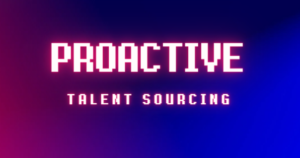
Hi Jonathan,
I have been working at my company for 4 years and a year ago was moved into a Talent Sourcing role. The role was new for me as well as my company. I recently attended SourceCon and came across your blog and have been really trying to focus on creating a proactive sourcing approach to add value to my team. Right now though, I am adding value very reactively and getting burned out. I would like to create more of a proactive sourcing approach where I conduct market research to share with the hiring managers and recruiters and am interested in what the best practices for sourcing are in the market.
I follow your blog and find it so helpful and interesting! I was wondering if you would be open to chatting about your thoughts on best practices and creating a strategy.
First off, thank you for reading my blog! I’m very passionate about helping other Talent Sourcers across the globe and I’m glad that I was able to make an impact. In my experience, most companies only have one Talent Sourcer on the team and they are responsible for generating passive applicants. Currently, the job market in North America is on fire. We haven’t experienced such a competitive time to find and source leads in the past 50 years. The reality is most companies are understaffed and they have a lot of job openings. The average Talent Acquisition team is facing many challenges and because of these reasons, Talent Sourcers need to build a proactive sourcing strategy into their process.
What is proactive sourcing?
Proactive sourcing Is the process of using data to understand your current and future job requisition needs. Through data, you can understand which areas you are consistently hiring for. For example, my company figured out that we’re averaging 6-12 yearly hires in the industrial designing space. With that data, we created a pipelining strategy to reach out to industrial designers on a monthly basis. We would proactively reach out to passive leads and save their information in our CRM. If you wanted to get more creative, I wrote a post about building out a passive email newsletter (here).
Tracking all your sourcing efforts
Everything revolves around having data. If you want to make a case for building out a proactive strategy you first need to track all your data. This includes all your outreaches (contacts, screens, and submittals) per week. You should also track all your hires for the year – it’s fairly easy to find this data in your ATS system. We have Workday at my company and our HRIS team built out a dashboard for us to see all the hires per year in each department.
Building a case using data
Once you have all your data, you need to will need to present your data in either an excel document or in a PowerPoint presentation. You can build a case for why you should be proactively looking for certain niche skill sets. Say you’re team averages 10-15 Full Stack developers per year– you can present on why you need to proactively build a pipelining strategy. That means that you are dedicating a certain amount of hours per week to build a list of passive leads. Depending on your availability, you can even set up introduction calls with each passive lead.
Building a proactive sourcing model
Once you present your data to your Recruiting Manager, you can build the case for the need to proactively source leads. I would set a goal to contact a certain amount of leads on a weekly or monthly basis. The more you can proactively build a pipeline the better it will be when a position does open up. You will be able to fill a job way faster this way compared to cold-sourcing outreach.
Talent mapping strategy
This is a different strategy but still important to review! Talent Mapping is using job market analytics based on your companies competitors and market location. This helps you to understand your local job market. With this data, you can understand: which companies are hiring, averaging salary ranges, to college/university graduate rates etc. You can use this data to present to your hiring managers on the level of difficulty it will take to find and source for passive leads. You can learn more about Talent Mapping (here).
Final thoughts
The sooner you can build a proactive sourcing model into your process the better you will be in the long term. Hopefully, this strategy will help relieve some pressure from your hiring managers.
Recommended Reading:
How to Prepare for a Recruiter Job Interview
Amy Miller Interview Spotlight
Top Diversity Recruiting Tools to Find Talent
- AI Search Will Transform Talent Sourcing Forever - January 10, 2025
- Build an AI Sourcing Assistant using ChatGPT 4 - January 10, 2025
- Top Recruiting Leaders to Follow in 2025 - January 8, 2025
